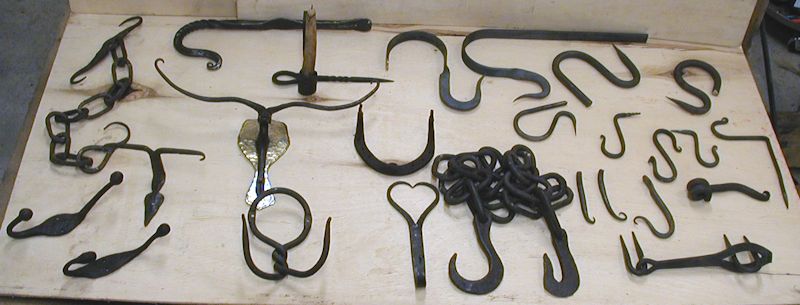What's So Special About The "Hook"?
or- The Terminator
A Short Essay
Created: September 23, 2012
Last Revised: October 22, 2023


My local blacksmith club recently started to have "Themed" meetings.
They asked me to demonstrate at the first one of these "Themed" meetings.
They chose "The Hook" to be the theme!!!
Wow! What can I do with "Hook" that hasn't been done thousands of times before?
OK---
What is a hook and what should I do about that?
Demonstration Title: "THE TERMINATOR"!!!
Well, "terminating a bar" and making a hook are just about the same aren't they?
What is a Hook? (Dictionary Definition)
Hook:
1.
a. A curved or sharply bent device, usually of metal, used to catch, drag, suspend, or fasten something else.
hooked [huk't]
adj
1. bent like a hook
2. having a hook or hooks
3. caught or trapped
4. a slang word for married
5. Slang addicted to a drug
6. (often foll by on) obsessed (with)
hookedness [hukednes] n
Terminating the end of a bar--- regardless of what you are working on: You have to do something with the ends of the stock that you are working on.
I am going to divide "termination" into three classes:
1.Safety
Doing just enough with the end of the piece so that no one or nothing gets hurt.
2.Decoration
Doing something with the end of the piece to make it graceful or to fit it in with the rest of the piece.
3.Utility
Doing something with the end of the piece that specifically fits a FUNCTIONAL design intent of the product.
For a given product, one or more of these classes may apply.
And within each class, there must be multiple subsets.
As you read the following explanations, look at the picture at the top of this page and try to identify some of
the items there with the text below.
With hooks, the TERMINATION IS what makes a hook a hook! And it depends a lot on what the hook is to be used for:
Post hook, drive
Post hook, screw-in
Post hook- with flat for screw or nail
S-Hook
Hooks on log chain
Gate latch hook
Coat hook- With balls on the ends
Fish hook
Harpoon
Pot rack with hooks.
------------------------------Hang up a coat: The hanger needs to be non-sharp so as to not tear the garment
Meat hook: The business end needs to be moderately sharp to pierce the meat and the then get thick enough to support the meat without the meat tearing off.
Chain hooks: Chains, as in "log chain" usually have a slip hook on one end and a grab hook on the other.
-Grab hook: Just pointed enough to easily fit over one of the links of the chain it is attached to.
-Slip hook: Can be pretty dull, but must be large enough so the chain links can SLIDE through it.
Decorative S-Hook: Here's where the scroll comes in as a decorative termination to the hook function itself. It's both utilitarian, since it replaces a possibly ragged end from the stock being cut off the bar, and decorative since it adds an "organic" element to the piece.
Fish Hook: Very sharp to pierce flesh and barbed so it can't come out easily.
Gate hook: Distinctive bend in the end of the hook to keep it from lifting if it is jarred.
Most people who do any blacksmithing at all have made some sort of hook.
One can focus on making simple, functional hooks rapidly, in an automated, highly productive mode or one can make
them one at a time, with great care, and an artful design.
They say that there are only 8 basic processes to blacksmithing. A hook can utilize as few as two
(hot cutting and bending).
Or--- One can apply all 8 processes with a little extra effort.
One can choose to make hooks with no fixtures at all (other than hammer and anvil) or one can automate the whole
process, even to the point of eliminating forge and anvil totally.
I usually use a minimum of fixturing when I demonstrate to the public because I want the audience to see as much
of fire, hammer and anvil work as I can show them.
I usually use scroll terminations that are turned solely with the hammer rather than using a scrolling pliers.
In my view, it is important for all budding blacksmiths to learn WELL the basic processes and how to combine them.
So, before building fixtures, for making hooks or for making anything else, one needs to learn how the process can be
done by hand.
Developing the manual skills WELL is very satisfying. And, having the ability to accurately produce complex
structures with a minumum of tools can stand you in good stead when emergency situations arise.
Here's another look at really "knowing" or "owning" the craft of blacksmithing:
"---
Since the industrial revolution there has been a continuous dialogue between philosophers, architects, mechanics, artists
and craftsmen which seeks to explain the relationship between man and machines. Influential thinkers such as Pugin, Ruskin,
Eastlake, Sullivan, Wright, Stickley, Hubbard, Moholy-Nagy, and others have all written extensively on this subject, with a
wide range of divergent views. In recent times, the English woodworker, David Pye, made a distinction between "hand work"
and "machine work." He defined "craftsmanship" as the "workmanship of risk," and contrasted this with the "workmanship
of certainty." The real question, Pye asks, "Is the result predetermined and unalterable once production begins?"
(David Pye, "The Nature and Art of Workmanship" Cambium Press 1998)
For me, the quote above explains the difference between using a scrolling pliers and scrolling jigs to turn scrolls
vs. developing the personal skills needed to form them freehand.
--------------------------------------------
You can make hooks from any size stock you have on hand, but here are some good sizes that are easy to work:
3/16 square
1/4" square
3/8" round
1/2" round
1/4" X 3/4"
----------------------------